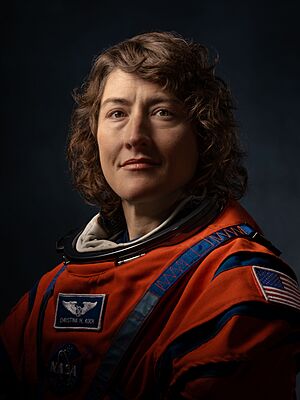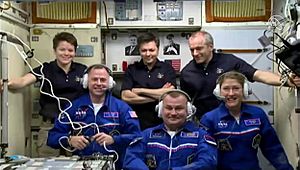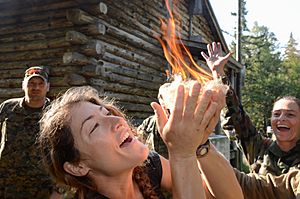Christina Koch facts for kids
Quick facts for kids
Christina Koch
|
|
|---|---|

Koch in 2023
|
|
| Born |
Christina Hammock
January 29, 1979 Grand Rapids, Michigan, U.S.
|
| Space career | |
| NASA astronaut | |
|
Time in space
|
328 days, 13 hours, 58 minutes |
| Selection | NASA Group 21 (2013) |
|
Total EVAs
|
6 |
|
Total EVA time
|
42 hours, 15 minutes |
| Missions | Soyuz MS-12/MS-13 (Expedition 59/60/61) |
|
Mission insignia
|
|
Christina Koch (born January 29, 1979) is an American engineer and NASA astronaut. She was chosen by NASA in 2013. Christina studied electrical engineering and physics at North Carolina State University. She earned both a bachelor's and a master's degree there. Before becoming an astronaut, she worked for the National Oceanic and Atmospheric Administration (NOAA).
On March 14, 2019, Koch traveled to the International Space Station (ISS). She worked as a flight engineer for three missions: Expedition 59, 60, and 61. On October 18, 2019, she and Jessica Meir made history. They were the first two women to do an all-female spacewalk. They fixed a power unit outside the ISS.
Christina Koch set a new record on December 28, 2019. She stayed in space longer than any other woman. She returned to Earth on February 6, 2020. Her mission lasted 328 days.
Koch was also chosen for the Artemis II mission. This flight plans to circle the Moon in 2026. If successful, she will be the first woman to travel beyond Earth's orbit. In 2020, Time magazine named her one of the 100 Most Influential People.
Contents
Early Life and Education
Christina Koch was born in Grand Rapids, Michigan. She grew up in Jacksonville, North Carolina. Her parents are Barbara Johnsen and Ronald Hammock. From a young age, Christina dreamed of becoming an astronaut.
She finished high school at the North Carolina School of Science and Mathematics in 1997. Then, she went to North Carolina State University. She earned two bachelor's degrees in 2001. These were in electrical engineering and physics. In 2002, she received her master's degree in electrical engineering. In 2001, she also joined the NASA Academy program. This program was at the Goddard Space Flight Center.
Working in Science and Space
Christina Koch has worked on many space science projects. She helped develop instruments for space missions. As an electrical engineer at NASA, she worked on tools for studying astrophysics and cosmology. These are fields that study the universe and its origins. During this time, she also taught physics at Montgomery College.
From 2004 to 2007, Koch worked in the United States Antarctic Program. She spent three and a half years in the Arctic and Antarctic regions. She even spent a winter at the Amundsen–Scott South Pole Station. There, temperatures could drop to minus 111 degrees Fahrenheit. She also worked at Palmer Station. In Antarctica, she was part of firefighting and rescue teams. She said living at the South Pole was tough. It meant months without seeing the sun. She also had no fresh food or mail.
From 2007 to 2009, Koch was an electrical engineer at Johns Hopkins University. She helped build instruments to study radiation particles. These instruments were for NASA missions like Juno and Van Allen Probes. Later, she worked for the National Oceanic and Atmospheric Administration (NOAA). She was a field engineer in Alaska and a station chief in American Samoa.
Becoming an Astronaut
In June 2013, NASA chose Christina Koch to be an astronaut. She was part of NASA Astronaut Group 21. She finished her training in July 2015. This meant she was ready for space missions. Her training included learning about the International Space Station. She also practiced spacewalks and robotics. She had flight training and learned wilderness survival skills.

On March 14, 2019, Koch launched to the International Space Station. She flew on the Soyuz MS-12 spacecraft. She joined the Expedition 59, 60, and 61 crews.
Christina Koch was supposed to do her first spacewalk on March 29, 2019. It was planned to be an all-female spacewalk with Anne McClain. But due to spacesuit sizing, the plan changed. On October 18, 2019, she made history with Jessica Meir. They completed the first all-female spacewalk. They did two more all-female spacewalks in January 2020. These spacewalks helped upgrade the ISS power systems.
On April 17, 2019, Koch's mission was extended. She stayed in space until February 2020. She returned to Earth on February 6, 2020. Her 328-day mission was the longest continuous stay in space for a woman. This broke the previous record held by Peggy Whitson. NASA used her extended mission to study how long space travel affects women. They looked at physical, biological, and mental changes.
Christina Koch was chosen for NASA's Artemis program. On April 3, 2023, she was named a mission specialist for Artemis II. This mission plans to fly around the Moon in 2026. It will travel 6,400 miles beyond the Moon's far side. She will fly with NASA astronauts Reid Wiseman and Victor Glover. Canadian Space Agency astronaut Jeremy Hansen will also be on board.
Personal Life
Christina Koch lives in Texas with her husband, Robert Koch. She enjoys many outdoor activities. These include backpacking, rock climbing, and sailing. She also likes running, yoga, photography, and traveling.
Awards and Honors
Christina Koch has received many awards. These include the NASA Group Achievement Award for the Juno Mission in 2012. She also received the United States Congress Antarctic Service Medal in 2005. This was for her work in Antarctica. In 2005, she got another NASA Group Achievement Award for the Suzaku Mission. She was also an Astronaut Scholar from 2000 to 2001.
In December 2020, her old university, North Carolina State University, gave her an honorary Doctor of Sciences degree.
See also
 In Spanish: Christina Koch para niños
In Spanish: Christina Koch para niños



